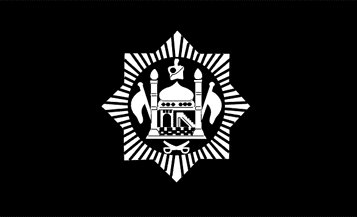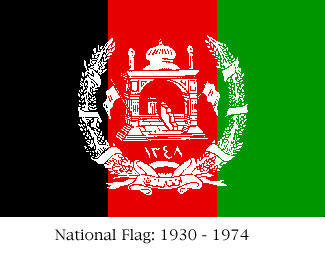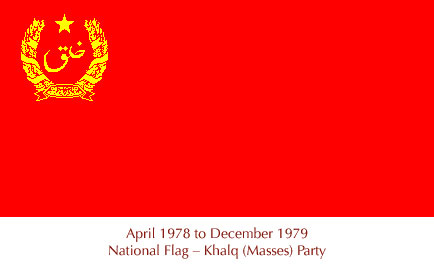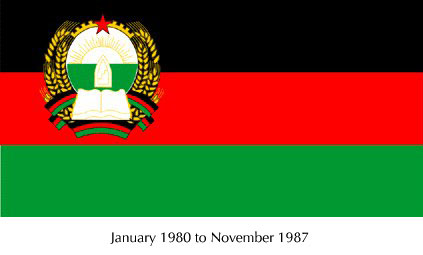Time line of Afghanistan (1919-1996)
Feudalist Social Reform (1919-1929): For over two centuries, Russia and England had battled to gain control of the strategic Afghanistan. When the Soviets came to power in 1917, they renounced all Tsarist claims on Afghanistan, and within two years England, which completely controlled Afghanistan's foreign affairs, could not contain the nation's surging independence.

Emir Amanollah (after 1923, Padshah Amanollah), heir to his assassinated father, became the monarch of Afghanistan in 1919. Among Amanollah's first acts was to launch a war with England when it was weak from WWI and Indian revolts, in what was called the "Third Anglo-Afghan War". Afghanistan established an alliance with the Soviet Union, singing a treaty of friendship, before pouncing on the English army and driving it from Afghanistan, singing the Treaty of Rawalpinidi (Aug 8, 1919) to end the war. See also: The Third Afghan War (1919)
Showing the influence of socialist ideals, Amanollah launched extensive educational reforms: elementary education was decreed free and compulsory for all people — women included. He created professional training schools and three secondary schools for children to continue their studies. Instruction in these schools was in a foreign language to prepare the children to continue their tertiary education abroad. These measures on education met with economic problems (not enough teachers, books, etc), and strong opposition from the orthodox leaders as a result of co-ed schooling.
In another leap to the left, Amanollah created the Family Code of 1921. It became illegal to marry children and in-breeding was also outlawed. The sale of a women into a marriage, considered important economic transactions in the life of the tribe, were reformed, but not abolished. The price of the bride, wedding expenses, and doweries were limited. A widow was no longer "owned" by the husband's family. In 1928, Queen Soraya, Amanollah's wife, lifted her veil in public — the first time an Afghan women had ever done so. The lifting of the veil had been decreed into law shortly before, but it was not mandatory.
A constitutional monarchy was established in a written code of laws, and Amanollah struggled to usurp the domination of Shari'a (Islamic Law), administered by Muslim judges ("qazi"). He recognized that getting rid of these laws was impossible, and he thus wrote his laws to be compatible. Even still, a rebellion occurred in 1924 after leading Muslims declared parts of the law were un-Islamic, including the penal code. Amanollah deferred, and ended the Khost Rebellion with a compromise. The qazis were nevertheless still enraged, as their power remained weakened: only in minor crimes could they decide whichever punishment they deemed necessary — serious and major crimes (from murder to adultery to alcohol consumption, etc) had preset punishments.
Amanollah struck out to reduce the strength of the tribal aristocracy. He eliminated ranks, titles, and royal benefits -- and replaced them with a system of reward for work instead of reward for position. Amanollah changed the tax system: where once the tribes kept part of the revenue, now, official tax collectors were employed that took all taxes directly to the government. Amanollah reformed the army — no longer abiding by the choices the tribal aristocracy made for "conscripts" — establishing instead a conscription lottery. During the Khost Rebellion, the ineffectiveness of the new army system was starkly revealed, and Amanollah had to return to the tribal levy system, which some tribes agreed to, so long as he stopped his reform process.
From December 1927 to July 1928, Amanollah traveled around the world, noting the methods of Kemal Ataturk of Turkey and Reza Shah of Iran in modernizing their own nations, he came back stepping up his program of modernization. He sought to create an elected parliament, make military service universal, and strengthen the position of women. Believing that the Loya Jirgah would not accept modernization, he attacked their power by establishing educational requirements to be a cleric, reducing their subsides, and seeking to replace them with graduates from law school. Amanollah was finished. Orthodox and tribal leaders, possibly with British assistance fearful of leftist reforms, took to their arms in November, 1928. By January 14, 1929, Amanollah abdicated.
The following is a short history as a place holder for a more detailed time line to come.

After several power struggles, Shah Mohammad Nader comes to power in 1929, but would rule for only four years, setting the tone of a return to orthodox Islam. In 1933, Nader is assassinated, and his son, Shah Mohammad Zahir takes control. Stronger ties are built with the Soviet Union, including extensive bilateral trade agreements. By 1950, Soviet economic and military advisers are a constant feature in Afghanistan. The Soviets build much of Afghanistan's road network and airfields.
In 1953 Muhammad Daud, cousin of King Mohammed Zahir Shah (king since 1933), becomes Prime Minister. Daud begins to modernize Afghanistan rapidly with economic and military aid from the USSR. In 1964, giving way to US pressures, King Zahir Shah removes Daud as Prime Minister, and creates a "constitutional" monarchy.
In 1973, Muhammad Daud leads a coup to overthrow the King, and installs himself as president. He opportunisticly attempts to get aid from both the USSR and Western nations, to little avail. The nation's political majority, composed of Socialists and religious radicals, oppose his policies.
In 1978, Daud attempts to imprison members of the People's Democratic Party of Afghanistan (PDPA) — in so doing, the Party rises up to fight back, and overthrow Daud. Noor Muhammad Taraki becomes president of the new Republic on 27 April 1978, and proclaims the nation "socialist".

The Afghan Civil War: Taraki announces a sweeping revolutionary program, including land reform, the emancipation of women, and a campaign against illiteracy. Late in 1978 Islamic traditionalists and ethnic leaders who objected to rapid social change begin an armed revolt. By the summer of 1979, the rebels begin receiving massive military aid from the United States, in an effort to induce the Soviet Union to invade Afghanistan. [A] In September Taraki was deposed and later assassinated, while the rebels had firm control over most of the countryside. Amin, his successor, tried vigorously to suppress the rebellion and resisted Soviet efforts to make him moderate his policies. The government's position deteriorated, however, the Soviets became extremely worried about U.S. military involvement on their border, and on December 25, 1979, Soviet forces invaded.
The Soviets quickly won control of Kabul with a Soviet Spetsnaz 1 unit storming the Presidential Palace, and other important cities. The Soviets executed Amin on December 27 and installed Babrak Karmal, leader of PDPA's Parcham faction, as president.

[C]
... [thorough outline to come] ...
further reading: Afghan War (1979-89) (Magazine)
The Soviet withdrawal was agreed to in April 1988; the last Soviet soldier left Afghanistan on February 15, 1989. Exact casualties of Afghanis are unknown. General estimates for all sides — the government, the rebels, and civilians — are around 1.3 million people. There were over 642,000 Soviet soldiers (mostly from the Soviet 40th Army) who served in the war. The Soviet military lost 14,453 soldiers (of which 13,833 were from the Army). 53,753 soldiers were wounded, while of those 10,751 were invalided because of the war. 415,932 were sick at some point in their duty (the most serious ailments being hepatitis (115,308) and typhoid fever (31,080)). [B]
| Causes of Death | |
|---|---|
| KIA | 9,511 |
| by wounds | 2,386 |
| Disease and Accidents | 2,556 |
| Total: | 14,453 |
| Combat Equipment Losses | |
|---|---|
| Aircraft | 118 |
| Helicopters | 333 |
| Tanks | 147 |
| Armored Personnel Carriers | 1,314 |
| Artillery | 433 |
| Cargo and fuel tanker trucks | 11,369 |
From February 1989 the pro-Soviet government of Mohammad Najibullah continues to fight the Islamic fundamentalist Mujahideen on it's own — the government receives no Soviet Aid, and the US shuts off all contact with their "Freedom Fighters". After three years of battle, the fundamentalists finally win in April of 1992. The Mujahideen refuse, however, to allow any other ethnic tribe to control the nation, and fierce genocidal fighting breaks out among themselves — between the Pashtoon, Tajiks, Uzbeks, Hazaras and Turkmen.
In October, 1994, the Taliban movement is created among former Mujahideen (primarily Pashtoon) with the support of Pakistan, winning their first territory of Kandahar. In August, 1995, the oil company Bridas (which is shortly thereafter bought up by British Petroleum) meets the Taliban government for the first time to discuss building an oil pipeline through the country. In February of 1996, they sign an agreement to build the pipeline, regardless of on-going fighting, beating U.S. oil competitor Unocal which is hesitant about agreeing to the $2.5 billion investment without consolidated Taliban control. In September, 1996, the Taliban secure Kabul, dragging the Socialist Najibullah and his brother, having lived for four years in a United Nations compound, into the streets, hanging them from a traffic light. In the following month, the Taliban enforce Sharia Islamic law in Kabul. All co-ed schooling is strictly forbidden, all girls schools are shut down and boarded up. Women are forced out of the work force entirely, and are stripped nearly all access to health care.
Sources: All information herein, unless otherwise noted, is derived from the book "Arc of Socialist Revolutions", by Suzanne Jolicoeur Katsikas. Cross checked with the Encyclopedia Britannica.
[A] Interview with Zbigniew Brzezinski
U.S. President Carter's National Security Adviser, 1998
[B] Soviet casualties and combat losses, by G.F. Krivosheev
[C] Historical Flags (Afghanistan)
Compiled by: Brian
Baggins
Online Version: Marxist History Archive (marxists.org)
2002. Permission is granted to copy and/or distribute this document under the terms of the GNU Free Documentation License.